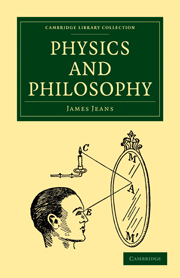Book contents
- Frontmatter
- Contents
- Preface
- I What are Physics and Philosophy?
- II How do we know? (Descartes to Kant; Eddington)
- III The two voices of Science and Philosophy (Plato to the present)
- IV The Passing of the Mechanical Age (Newton to Einstein)
- V The New Physics (Planck, Rutherford, Bohr)
- VI From Appearance to Reality (Bohr, Heisenberg, de Broglie, Schrödinger, Dirac)
- VII Some Problems of Philosophy
- Index
VI - From Appearance to Reality (Bohr, Heisenberg, de Broglie, Schrödinger, Dirac)
Published online by Cambridge University Press: 07 September 2010
- Frontmatter
- Contents
- Preface
- I What are Physics and Philosophy?
- II How do we know? (Descartes to Kant; Eddington)
- III The two voices of Science and Philosophy (Plato to the present)
- IV The Passing of the Mechanical Age (Newton to Einstein)
- V The New Physics (Planck, Rutherford, Bohr)
- VI From Appearance to Reality (Bohr, Heisenberg, de Broglie, Schrödinger, Dirac)
- VII Some Problems of Philosophy
- Index
Summary
The new physics just described was still based largely on Newtonian ideas. Indeed, in its theoretical aspects, it might not unfairly be described as a final attempt to explain the world in materialistic terms—as particles being pushed and pulled about in space and time. Nevertheless, the new physics had found it necessary to abolish most of the forces of pushing and pulling, replacing the gradual changes of motion of the particles under these forces by sudden and unpredictable jumps. These appeared to involve violations of the law of causality, both in the disintegration of radioactive atoms and also in the internal changes of ordinary atoms. We seemed to see Fate defying this law as she picked out certain atoms for disintegration or collapse and, by her apparently capricious acts, sent the universe along one path or another according to her whim.
On such lines the new physics had explained many phenomena which had hitherto seemed inexplicable, but it had by no means met with complete success. For instance, while it gave a perfect interpretation of the simplest spectrum of all, namely that of the hydrogen atom, it failed with more complex spectra. This was not necessarily a fatal objection; a few emendations and possibly a few new ad hoc assumptions might have effected a complete reconciliation, although this seems improbable.
- Type
- Chapter
- Information
- Physics and Philosophy , pp. 153 - 173Publisher: Cambridge University PressPrint publication year: 2009First published in: 1942

